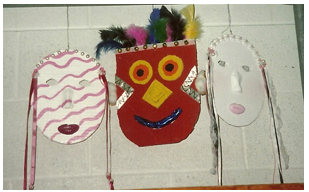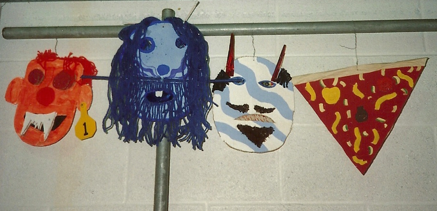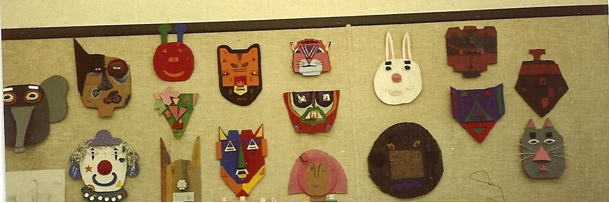Making Masks and Tribes
Making Masks and Tribes
An Activity Developed and Contributed by Susan Brasch
Objectives:
The participants will:
- Learn about the cultural significance of masks
- Create masks to hang on the wall using design and art elements
- Brainstorm to create their own “tribes” using the masks as a focal point
Audiences:
This activity can be enjoyed by all age groups but was used with middle-school and high school students.
Learning Opportunity:
The origin of the mask has been traced to pre-historic man. Depictions of masks have been found in various rock and cave paintings. Throughout history to the present, masks have been used to the cover the face for a variety of reasons—they have been used for protection, disguise, and entertainment or ritual practices. They are made from various materials, depending upon their intended use. The earliest use of masks was for rituals and ceremonies and the oldest found mask is from 7000 B.C. There are undoubtedly older masks made of leather and wood but they have not survived to the present day.
Masks can have been used in many places around the world. Some masks have been used in ceremonies with the purpose of communicating with ancestral spirits. Beside human faces, many masks are made in shapes of animals to communicate with animal spirits. One of the more common masks in Africa is an antelope which is a symbol of a farmer. Masks with closed eyes symbolize tranquility while bulging forehead symbolizes wisdom. War masks are made to scare the enemy with big eyes, painted colors and angry expressions incorporate into the carved faces.
In the Pacific Northwest, skilled woodworkers have made complex masks with movable parts using wood, leather, bones and feathers. They are used in shamanic rituals that represent unity between men, their ancestors and animals that the men hunt. They are also used to expel evil spirits from the sick. The ancient Aztecs in Latin America used masks to cover the faces of the dead; these masks were often made from precious metals such as copper and gold.
Here are some interesting facts about masks:
- Ancient Greek’s masks used in theater productions had brass megaphones positioned by the mask wearer’s mouth to amplify the actor’s voices.
- Duk-duk and tubuan masks of New Guinea were used to intimidate other members of the tribe and enforce social codes.
- “Moretta muta”, an oval mask that women wear for Carnival in Venice has no straps to be fastened to the head. Instead, a button on the inner side of the mask is held in the mouth of the wearer to keep the mask on the face.
- A star performer of Topeng dance from Indonesia can utilize 30 to 40 masks for his performance. No one else can use these masks because it is believed that to so will offend spirits that reside in them. When the Topeng dancer dies, masks that he used are kept in the exact place they were situated at the moment of his death.
- Ancient Egyptian death masks were made so the soul could recognize the body as well as help the deceased to be accepted by other divine immortals in the afterlife.
- In Chinese opera, all masks are color coded and every color describes personality of the character that the mask represents. This helps the audience to develop a better and faster understanding of the characters and their relationships.
- In African tribes, mask wearing is reserved mostly for men—even wearing of masks that represent female beauty.
- Japanese theater Noh masks are made with such a skill that they can convey different emotions with expressions depending on the angle in which the mask is seen or on the light that falls on the mask. All this is accomplished without having the masks contain any moving parts.
- In Korea, mask dances were methods of entertainment but were also used as an opportunity for satire and social commentary.
- In the past during wars and fights, masks were not only used for protecting the face but could also be methods of intimidating the enemy. This same dual purpose of protection and intimidating the “enemy” is used today in protective equipment for sports like hockey.
- In history, masks were also used as methods for inflicting punishment or shame.
Source: http://www.historyofmasks.net/
Supplies/Materials:
- Hefty cardboard (box cardboard works great)
- Construction paper
- White glue and glue guns with glue sticks
- Paint, brushes, markers
- Embellishments (feathers, sequins, beads, glitter, appliques, ribbons, pipe cleaners, etc.)
- Scissors
- Paper and pencils
Class Instruction:
Part One:
1. Share a little background about masks and how they have been used throughout time in various civilizations:
- As an art form
- For religious and cultural rituals
- For celebrations
- For protection
- For disguise
- To show status or importance
2. Show the class masks that you have made to give them examples of what they will be creating, explaining that their masks will not be worn but will be for display on the wall.

Mask Examples
3. Talk about the various shapes that can be used in making their masks and show examples.

Mask Shapes Example
4. Ask the class to think about the purpose of their masks as they are designing and creating—this will be important for the second phase of this activity.
5. Turn the class loose to make their masks, encouraging them to use their imaginations and make use of the embellishments and art supplies available.
Part Two:
1. Once all the students have completed their masks, ask them to divide into tribes. (Note: The number of tribes and number of members in each will depend upon your class size—you should have at least three members in each tribe. If you are working with school children, you may want to divide them into their tribes if you know who will work together well.)
2. For each tribe, ask the students to agree upon:
- The name of their tribe
- Where does their tribe live (e.g. mountains, ocean, desert, forest, island, etc.)
- What/how does their tribe eat (do they hunt or fish, do they grow your own food, etc.)?
- Describe what life is like for their tribe (what do they wear, where do they live, what kinds of work do they do, what do they do for fun, do they engage in sports, do they have enemies, what are their traditions, etc.).
- What rituals do they conduct with the masks they have made?
~Assign a specific ritual usage to each mask.
~Determine how the tribe uses each mask—could it be used for the celebration of birth or celebration for spring or the seasons, used for good luck or the hunt, used as protection against evil or bad spirits, used to bring rain or sunshine or abundant crops?
3. After the “tribes” have had a chance to brainstorm, ask the students to show their masks to the entire class and share information about their tribes and masks and what makes their tribes unique.
4. Display all the masks in the tribal groups with the name of the tribe, the purpose for each mask, and the name of the artist who created it.

Classroom Examples
Special thanks to Susan Brasch for sharing this activity. Susan has created artwork consistently since childhood and her art is owned and displayed in several corporate collections, art museums, art galleries and private collections. She is an artist-In-residence in schools and communities through the Nebraska Arts Council. She is also a professional workshop facilitator in conducting “Trusting Your Process” workshops using symbols and learning styles as keys to self-development, creativity, self-expression and communication. To learn more about Susan, please visit http://www.susanjbrasch.com .
